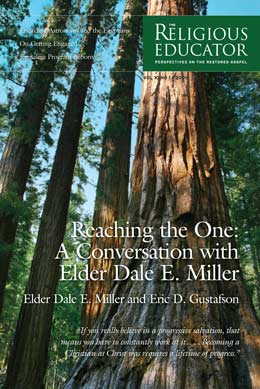Encircling Astronomy and the Egyptians: An Approach to Abraham 3
Kerry Muhlestein
Kerry Muhlestein, “Encircling Astronomy and the Egyptians: An Approach to Abraham 3,” Religious Educator 10, no. 1 (2009): 33–50.
Kerry Muhlestein (kerry_muhlestein@byu.edu) was an assistant professor of ancient scripture at BYU when this was written.
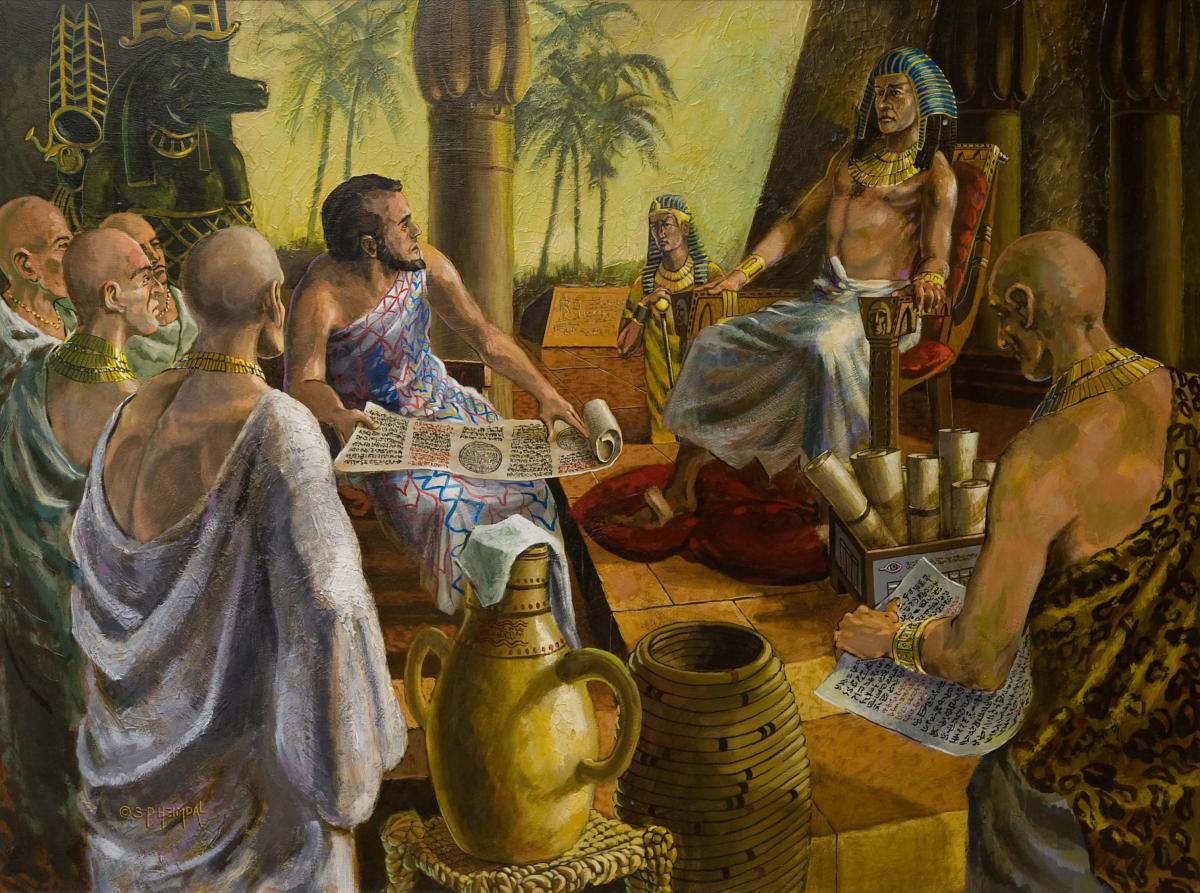 Stuart P. Heimdal, Abraham in Pharoah's Court.
Stuart P. Heimdal, Abraham in Pharoah's Court.
I have long held the view that the universe is built upon symbols, whereby one thing bespeaks another; the lesser testifying of the greater, lifting our thoughts from man to God, from earth to heaven, from time to eternity. . . . God teaches with symbols; it is his favorite method of teaching.
—Orson F. Whitney[1]
Abraham 3 is one of the most enigmatic sections of the Pearl of Great Price. Teacher and student together sense there is something more to the text than the meaning they are drawing out of it. Each thorough exploration gently nudges another layer of understanding from the text, but we always feel we have unraveled only the smallest portion of what it has to offer. Though I do not pretend to have a great key to unlock this revelation, I believe there are some apperceptive principles that cast light on Abraham’s night vision.
Certainly teachers can take a variety of approaches when teaching Abraham 3. Most students will be curious about the exotic names provided in verses 3 and 13, and it is worth time to address these questions.[2] Investigations into the Egyptians’ astronomical abilities and how Abraham may have contributed to these abilities are also worthwhile. Undoubtedly, the Egyptians of Abraham’s day conceived of a geocentric cosmos with particular emphasis on that “which the sun encircles (šnnt itn),”[3] denoting the earth. In many aspects, Abraham’s vision appears to be geocentric.[4] Yet Abraham also gains a “Kolob-centric” view of the universe.[5] However, some aspects of Egyptian astronomical thought are not “centric” at all. It is even possible that the vision fits no known astronomic approach because the Lord may have shown Abraham a model not yet understood by modern astronomers. However, I think we stumble when we attempt to understand Abraham’s vision in terms of astronomic paradigms.[6] It is quite likely that the Lord was describing astronomy and the heavens allegorically in order to teach doctrinal, not astronomical, principles. While attempting to understand astronomical principles has merit (though inconclusive attempts have certainly been used against us[7]), and while there may be an understandable cosmic paradigm to be teased out of the narrative, it seems that the allegorical teachings are the weightier matters as far as the gospel classroom is concerned.
Abraham was no beginner in astronomy. He tells us he has the records of the fathers and these records contain “a knowledge of the beginning of the creation, and also of the planets, and of the stars, as they were made known unto the fathers”; Abraham continues by making it clear that the information he records is “for the benefit of [his] posterity” (Abraham 1:31). As such, we must not only ask ourselves what the knowledge provided in Abraham 3 meant to those in Abraham’s time, but also what he meant for us, his latter-day posterity, to derive from it. This requires both an intensive investigation into Abraham’s era and into the ramifications of the vision for our day.
It is interesting to note that Abraham appears to have two distinct visions, one via the Urim and Thummim and recorded in the first part of chapter 3, and the second as he speaks with the Lord face to face, beginning somewhere between verses 10 and 12 (it is unclear when Abraham goes from hearing the Lord via the Urim and Thummim to talking with Him face to face). In fact, the first part of the chapter may not have been a vision but may have consisted of Abraham viewing the stars with his naked eye and conversing with the Lord about what he saw by means of the Urim and Thummim.[8] The second part is surely a vision. In each of these visions, Abraham sees something of the cosmic system, which the Lord then uses apperceptively to teach doctrinal principles.[9] In both visions, the principles taught are similar, but the first vision seems to discuss these principles on a more general level, and the second on a more specific level. To elucidate the lessons the Lord is teaching Abraham—and teaching us through Abraham—we must first ask some questions.
Purposes of Astronomy
To understand the symbols the Lord is using in this revelation to Abraham, we must ask ourselves, why is the Lord talking to Abraham about the stars? While the Lord often teaches His prophets about the heavens, He does not always teach the same thing in each encounter. For example, when Moses learns of God’s many creations, it is to help him understand the vastness of God’s great work and mankind’s centrality to that work (see Moses 1:32–39). While we do not know what Joseph Smith learned about the heavens from God, it is clear he learned something that helped him understand the degrees of glory to which mankind is headed (see D&C 76:70–71, 96–98). But why was Abraham shown a vision of the stars and planets? What was the point?
The Lord Himself partially answers this question: “Abraham, I show these things unto thee before ye go into Egypt, that ye may declare all these words” (Abraham 3:15). What words did the Lord want Abraham to declare? If the Lord is referring to the words He uses to describe the rotations of Kolob, the earth, the moon, and other celestial bodies, it is possible the Lord simply wanted Abraham to teach the Egyptians astronomy. The Genesis account of Abraham’s visit to Egypt emphasizes that Abraham was enriched there (see Genesis 13:2). Perhaps the Lord used Abraham’s astronomic awareness to introduce him to Pharaoh’s court, where he would be made wealthy and thus return to the promised land in a position of power. However, the phrase “all these words” indicates that Abraham was to teach not only astronomy but also gospel principles the Lord explained through astronomic means.
Egyptian Symbols
If this is the case, why did the Lord choose astronomy as the symbolic medium of His message? Why subscribe to this set of symbols? Of course, the Lord has not given us a direct answer to this question, yet there are some things we can reason out with a certain degree of confidence. While this is not the place for a detailed investigation into Egyptian astronomy, some ideas are worth highlighting so we may understand the magnitude of the symbolic language Abraham was to employ in Egypt.
It is indisputable that the Egyptians set significance to the movements and domains of celestial bodies. For instance, after the annual disappearance of Sirius (Sopdet), the Egyptians knew that the rerising of the Dog Star generally coincided with the annual flood of the Nile. The flood of the Nile was a type of rebirth, and thus the rebirth of the star was a harbinger of the rebirth that Egypt experienced each year. Sirius was also believed to serve as a guide to the deceased as they journeyed through the stars.[10]
The Egyptians designated Sirius as one of thirty-six stars known as decans because of the heliacal role they played in a complex calendar system in which one decan replaced another every ten days. Our knowledge of this system stems from astronomic paintings on a series of coffins from just before Abraham’s time. These paintings make it clear that in Abraham’s day the Egyptians placed significance on the movement of the stars.[11] This is further reflected in one of the long-standing titles of the head priest of Heliopolis (biblical On), who was known as the chief observer.
Many planets and stars played a particularly important role in Egyptian culture. Their gods were believed to have left the earth to reside in the sky;[12] the moon was associated with the god Thoth, the sun with Ra, and Orion with the god Osiris. Of particular import to the king, who was associated with Horus, were the planets Jupiter, Saturn, and Mars, which were also associated with Horus. Moreover the king would have paid particular attention to what Abraham had to say about the “greater light which is set to rule the day” (Abraham 3:6) because the king was integrally tied to Ra, the sun, and its journey.[13]
Information about the stars was also important to the king. Stars such as Gemini and Deneb were seen as significant markers in the known course of the sun through the stars. One of the most prolific of early kingship images was the belief that the king was destined to become one of the circumpolar stars (the ihmw-sk, the stars “that did not know destruction” because they did not disappear).[14] In the afterlife the king could also become Sirius.[15] Additionally, Sirius was seen as his sister,[16] which may be explained by references in which Sirius is also identified with Isis[17] (whereas the dead king is Osiris). Furthermore, Sirius was associated with the king’s daughter[18] and the king’s father.[19] Orion was described both as the king[20] and as the king’s brother,[21] and Venus as his daughter[22] and his guide.[23] Amenemhet III, a likely contemporary of Abraham, wrote on the top of his pyramid that he was “higher than the heights of Orion.”[24]
These few references amply illustrate the point: the Egyptian king and his court were aware of and keenly interested in the movements of the sun, moon, planets, and stars. In our era of large cities and electric lights, it is hard to picture how much these celestial bodies were part of Egyptian life. Most students do not regularly see starry nights because of light pollution. The natural nocturnal luminaries were particularly striking in Egypt, where most nights were cloudless and very clear. The lustrous bodies of the night sky were overlarge; they dominated the night landscape and forced their way into the minds and visions of every Egyptian soul. They were a much greater and pressing presence for these ancient inhabitants than most of us would naturally assume. Because of this powerful, intrusive sight, the stars spoke loudly to the Egyptians, whether they wanted them to or not. Their movements and power were an inescapable noise raining upon the eyes of our ancient counterparts.
In my estimation, this is why Abraham would find the language of the stars to be a meaningful mode of communication with the Egyptians. In modern missionary parlance, astronomy enabled Abraham to build on common ground, and his expertise in this area helped him build a relationship of trust. If the Lord wanted to find ground that was both common and persuasive as a vehicle for teaching Pharaoh and his people about the gospel, astronomy was an effective choice not only because the Egyptians would be interested, nor solely because they were accustomed to celestial bodies carrying symbolic teachings, but also because the movements and principles of the stars and planets lend themselves to a powerful message.
Essentially the Lord was teaching Abraham and the Egyptians by symbolism as He so often does. As we recognize and understand these symbols, we not only unlock information regarding this specific revelation to Abraham, but we also become more familiar with the language of symbolism. Working through these symbols equips our students to work through others on their own; it should help students develop both scriptural abilities and confidence in those abilities.
There is another lesson to be learned. When we see the pains to which the Lord goes to help one of His greatest prophets be prepared to share the gospel among a strange people, we realize how important this is to Him. In recording this experience for his posterity, Abraham emphasizes to us how much the Lord wants him to be prepared to keep the charge within the Abrahamic covenant to make the Lord’s name known throughout the earth. Here we see Abraham going through the Lord’s missionary training center; he is motivated to share the gospel, and he is equipped with both a message and tools (such as building on common ground) as he shares that message.
Governing Points of the Universe
To elucidate the principles taught by this astronomical message, I have created concentric circle models as visual aids (though we do not know if the Egyptians employed the idea of concentric circles at this time). Creating these models forces one to ask whether the governing body should be drawn at the center or as the outermost sphere. A good case can be made for both models. As noted, astronomy at the time was viewed geocentrically. This would put the earth at the center of the model with the greater bodies in the outer orbits. This model would have been particularly meaningful to the Egyptians. With our modern astronomical viewpoint, we tend to think of the center as the point of control or governance. The sun is the center of our solar system, governing the system by its gravitational pull. The sun is revolving around a central gravitational point in our galaxy (likely a black hole), and even the galaxies are revolving around a central gravitational pull in our supercluster of galaxies.[25] And yet, in the Lord’s analogy given to the Egyptians through Abraham, if the earth is at the center, then it is not the central point that governs, but the outermost point that encircles all else. This is aligned with Egyptian thinking in many respects, though it seems contrary to a geocentric point of view. For the Egyptians, encircling something was a powerful symbol of controlling or ruling over it, often including an element of protecting what was encircled. Power over creation was shown by Ra, who encircled the earth. The deceased wished to have such power by “going about (dbn) the two heavens, encircling (phr) the two lands.”[26] The deceased king is pictured as more powerful than even the gods by describing him as one who has “encircled (šn.n=k) every god in your arms, their lands and all their possessions. O King, you are great, you are wrapped around (dbn) like the circle which encircles (phr) the great rulers.”[27] In Egyptian thought, it is that which encircles that controls, not that which is in the center. Thus in a geocentric model, the vision given Abraham places God at the outer orbits.
On the other hand, there is some evidence that we would do best to draw Kolob, or the governing point, at the center of our model. Michael Rhodes has suggested an etymology for Kolob as coming from the “Semitic root QLB, which has the basic meaning of ‘heart, center, middle.’”[28] This is corroborated by Joseph Smith’s explanation of the center figure of the hypocephalus in facsimile 2 as Kolob. These ideas indicate a model with Kolob at the center. The central point of any model is completely a matter of perspective. The earth orbits the sun, but from our perspective it appears that the sun circles the earth.
Because Pharaoh already conceived of the sun circling the earth and other significant bodies moving in cyclical journeys around the earth and sun, he would have easily understood the concept that heavenly orbs revolved around each other in concentric circles. Thus the information given to Abraham in verses 3 through 7 would have made perfect sense. For each known orb there was another above it until the governing body was reached. Pharaoh could easily picture a cosmos which looked thus:
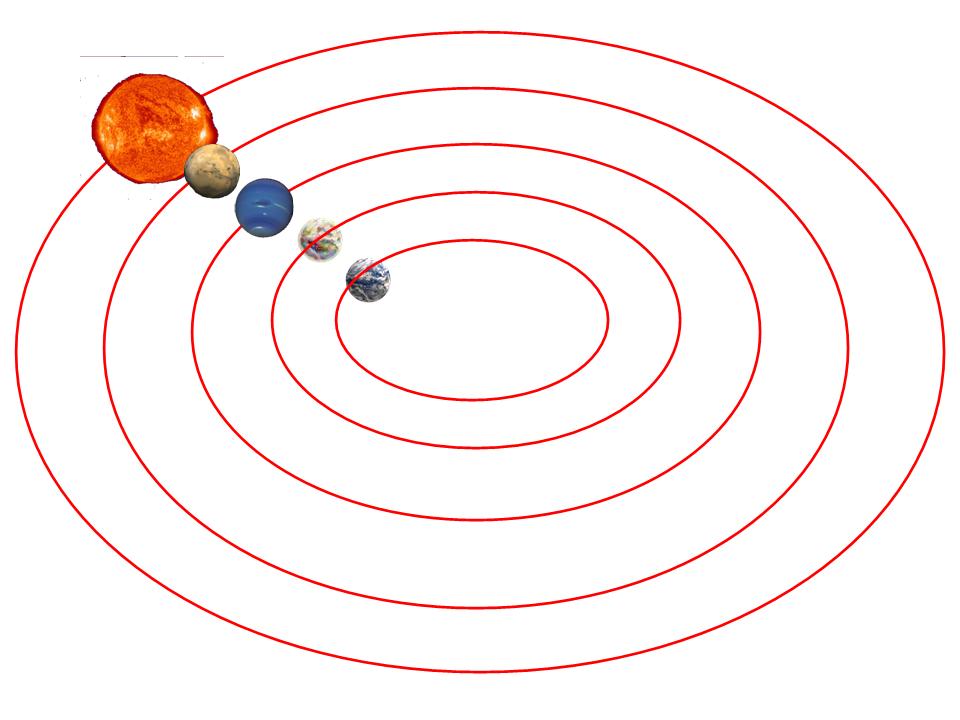 Fig. 1. Pharaoh’s concept of cosmos
Fig. 1. Pharaoh’s concept of cosmos
In the end, we cannot know which way Abraham or the Egyptians would have drawn their models, with the governing point at the center or as the body which encircles all else. I have chosen to make my illustrations with the governing point at the center because it is the most intuitive model. For us, saying that God is at the center means He is the focal, governing point, and pedagogically this is preferable. Thus for our purposes, the cosmos Abraham was explaining could look like Figure 2.
This picture of the cosmos helps us visualize what Abraham was teaching Pharaoh. The crucial information came in verses 8 and 9: “And where these two facts exist, there shall be another fact above them, that is, there shall be another planet whose reckoning of time shall be longer still; and thus there shall be the reckoning of the time of one planet above another, until thou come nigh unto Kolob, which Kolob is after the reckoning of the Lord’s time; which Kolob is set nigh unto the throne of God, to govern all those planets which belong to the same order as that upon which thou standest.” Here the concept of orbiting planets and their governing times was used as apperception to explain that a being—not a planet—was the governing source. This would give the glorious Egyptian king something to think about.
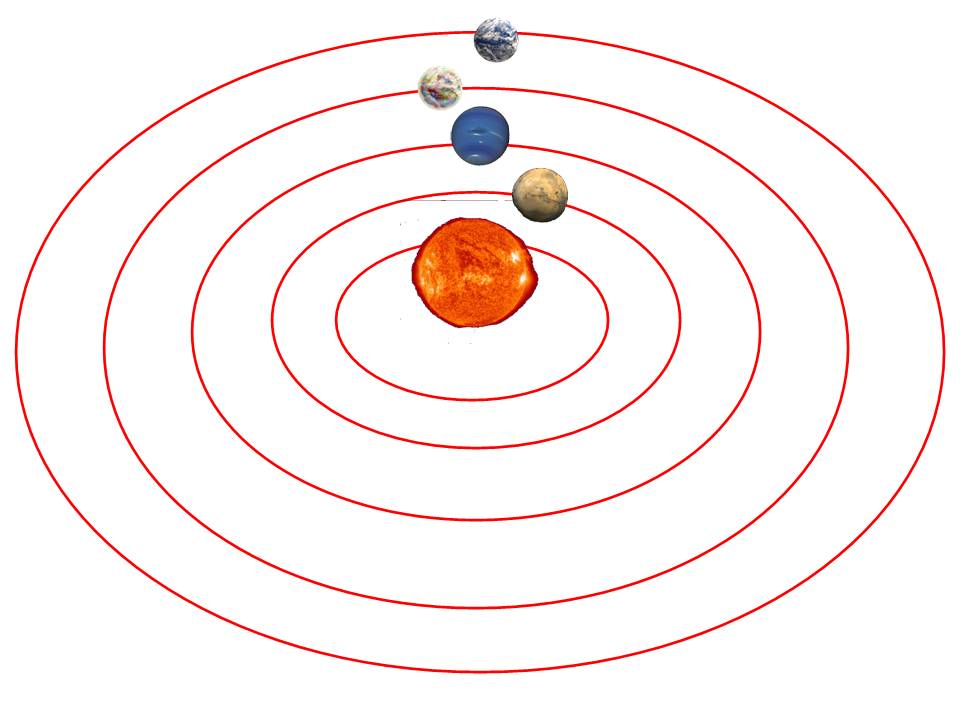 Fig. 2. Abraham’s concept of cosmos.
Fig. 2. Abraham’s concept of cosmos.
He would have clearly understood that there were many rulers upon the earth and that they possessed differing magnitudes of power. For example, the Egyptians knew of a Canaanite ruler in Jerusalem but considered him subservient to Egypt, and thus he would have been considered to be on one of the lesser orbits of rulers. Pharaoh probably also knew of Mesopotamian kings, perhaps King Ur-Nammu of the city of Ur. This leader would likely have been viewed as occupying an orbit closer to the Egyptian ruler. The Nubian kingdom of Kush had become powerful by this time, but again the Egyptians dominated this group. The probability is great that the Egyptian king considered himself to be the body that governed the orbits of leadership, the great centrifugal power controlling earthly leaders.
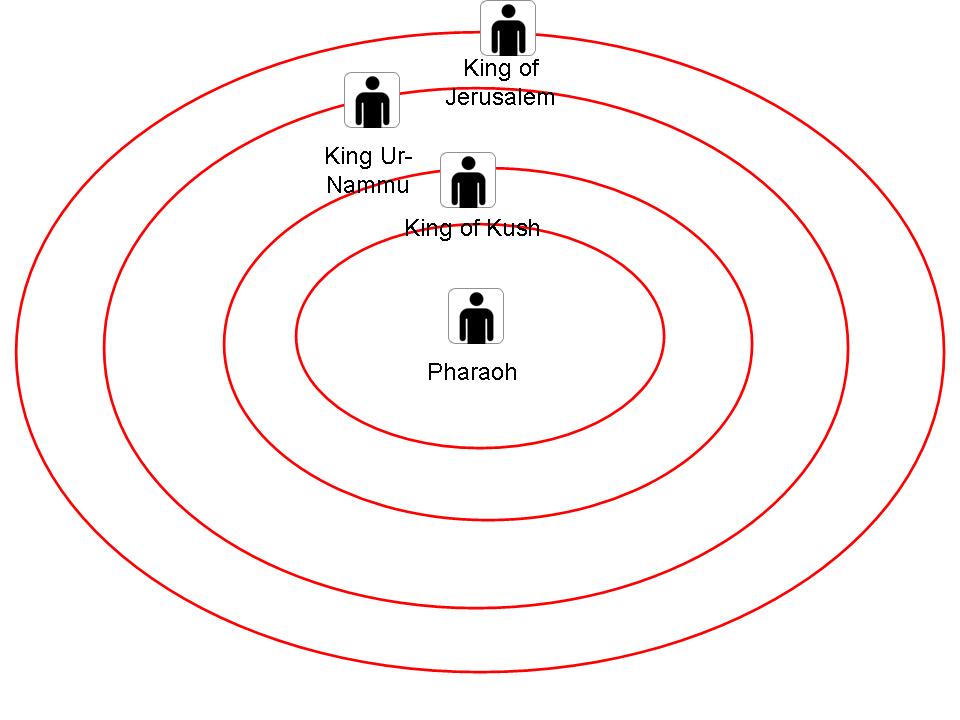 Fig. 3. Pharaoh-centered universe
Fig. 3. Pharaoh-centered universe
What would have been startling, yet logical, was the reasoning that if there were two facts, one was higher than another and there must be yet another higher still (see v. 8). Thus, if Pharaoh was above the king of Kush, it stood to reason that someone was above Pharaoh. Abraham’s assertion would have been that this series of successions continued, not merely until Pharaoh was reached but until God was reached. The paradigm presented to Pharaoh was that he was not the most high ruler after all.
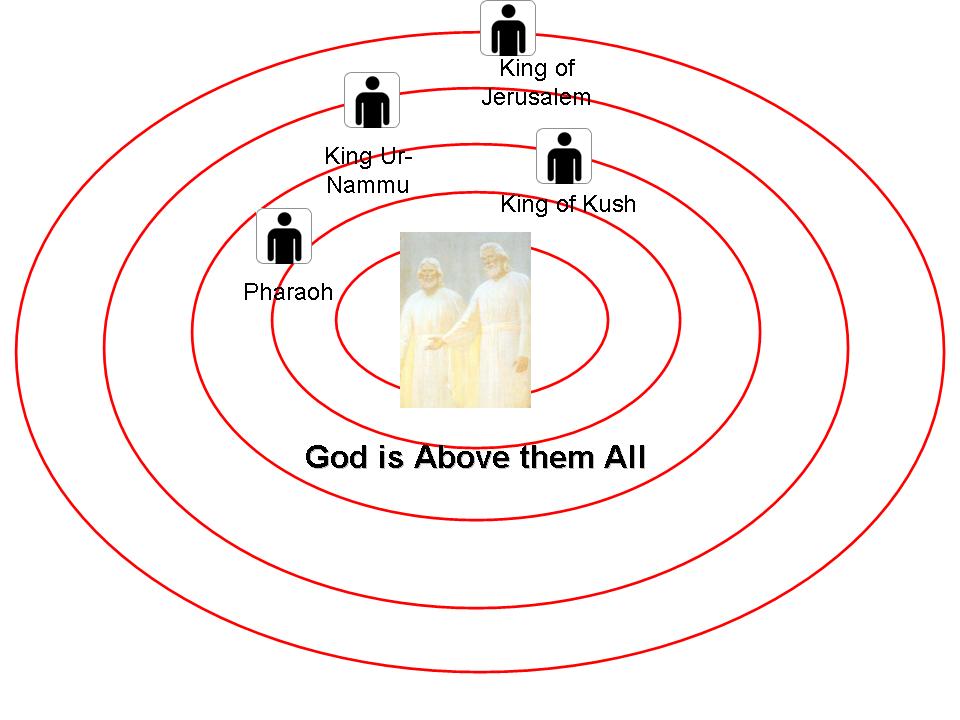 Fig. 4. Universe governed by higher powers
Fig. 4. Universe governed by higher powers
The teaching of astronomy would have gotten the king’s attention. The principles of government apperceptively taught would have made sense. This allowed Abraham to teach that mankind must fear God, not man (even a man considered semidivine). But the lesson did not necessarily stop there. These concentric circles of governance and order could also be used to teach of the organization of the kingdom of God on earth, which in Abraham’s day operated under the patriarchal order. Thus we, Abraham, and Pharaoh understand that we follow the orbits of governance from ourselves to our parents, grandparents, and so forth, until the person who reports to God is reached, and thus we again find God as the focal, governing point.
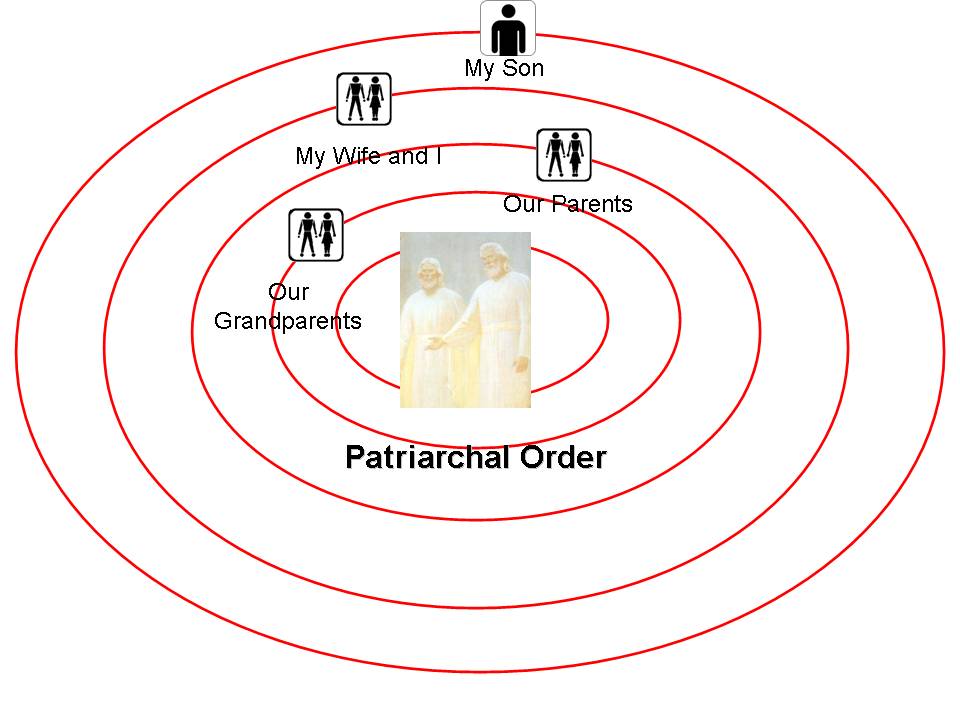 Fig. 5. Patriarch Order
Fig. 5. Patriarch Order
Incidentally, this can be used to understand current Church government as well, demonstrating that the symbolism in Abraham 3 speaks not only to Abraham’s generation but to ours as well.
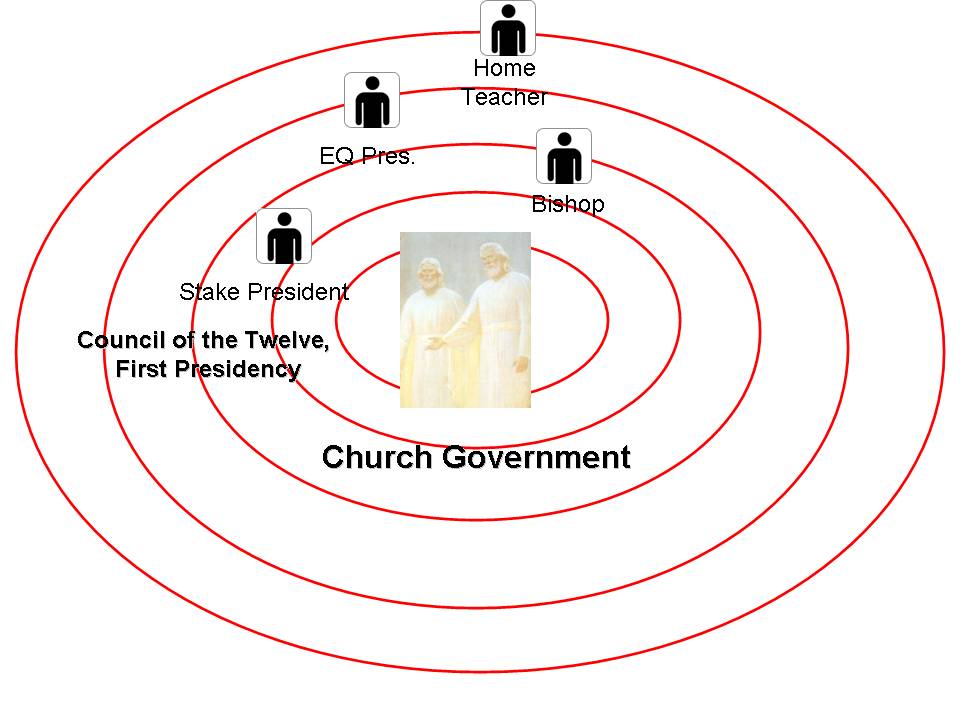 Fig. 6. Church government
Fig. 6. Church government
This God-centered view of the universe teaches Abraham, the Egyptians, and us another powerful message. Even within a gospel context it is easy to focus on various principles without tying them in to the great center, God. For example, it is easy to discuss modesty, honesty, the Word of Wisdom, or the law of tithing without connecting them to the center of the gospel: God, His Son, and the Atonement. Even such edifying principles as these can be distracting if they are disassociated from that central focus. President Boyd K. Packer described the Atonement as being “the very root of Christian doctrine. You may know much about the gospel as it branches out from there, but if you only know the branches and those branches do not touch that root, if they have been cut free from that truth, there will be no life nor substance nor redemption in them.”[29] As Thomas B. Griffith said in a BYU devotional, “If you cannot figure out the link between the topic you are to teach and the Atonement of Christ, you have either not thought about it enough or you shouldn’t be talking about it at church.”[30] When properly understood, the God-centered vision that Abraham 3 presents us should help us to remember that every aspect of the gospel is governed by its great center: God, His Son, and the Atonement.
The analogies Abraham is able to draw from the heavens increase because God seems to immediately show him an expanded vision of His creations: “And he said unto me: My son, my son (and his hand was stretched out), behold I will show you all these. And he put his hand upon mine eyes, and I saw those things which his hands had made, which were many; and they multiplied before mine eyes, and I could not see the end thereof” (Abraham 3:12). Not only did Abraham see more in the vision, but God also taught him more.
God’s Relationship with Abraham and with Us
For example, God expounded on the blessings of the Abrahamic covenant. It is difficult to know how much of the covenant had been established with Abraham at this point. In Genesis 12, just before going to Egypt, Abraham is told that the Lord will make of him a great nation and that the Lord will bless those that bless Abraham and curse those that curse Abraham (see Genesis 12:2–3). These are two of the most important aspects of the Abrahamic covenant.[31] It is tempting to consider the vision that is recorded as Abraham 3 as an extended record of when the Lord brought Abraham “forth abroad, and said, Look now toward heaven, and tell the stars, if thou be able to number them: and he said unto him, So shall thy seed be” (Genesis 15:5), except that in the Genesis account this takes place after the trip to Egypt. Perhaps there is a problem with the chronology of the Genesis account. During this same incident, Abraham makes sacrifices, divides the portions into halves, and walks before them in what is almost certainly symbolic of “cutting a covenant”—a literal translation of the Hebrew phrase—with God. As the sacrifice is accepted, the Lord covenants that Abraham will have a land of promise (see Genesis 15:9–21), another important aspect of the covenant. Yet only later is Abraham told, “I will make my covenant between me and thee,” and then has other aspects of the covenant confirmed and his name changed (Genesis 17:2–8).
It is difficult to tell if the covenant was established in stages—as it seems to be with us, who enter the covenant at baptism but more fully partake of it in the marriage covenant—or if it was given wholly at once and then reconfirmed in various ways at various times or if there is a problem with the Genesis text as we have received it.[32] Thus, we cannot be certain at what stage of the covenant Abraham was when he received the vision recorded in Abraham 3, but he at least knew something of it. He also had the covenant’s aspect of progeny reconfirmed when, in the midst of supernaturally[33] seeing the stars, God told him, “I will multiply thee, and thy seed after thee, like unto these; and if thou canst count the number of sands, so shall be the number of thy seeds” (Abraham 3:14). It is interesting that in the midst of seeing a vision designed to instruct him as to what he should teach the Egyptians, Abraham is reminded of how the heavens tie into God’s covenant with him.
The apperception analogies that God employs in this fuller vision take a step beyond those He had employed in the first. In those explanations God had focused on nondescript entities with God at the center, allowing for organizational and institutional comparisons. In the second vision God applies the same principles to the individual. After showing Abraham the vastness of His creations, He again speaks of the orbiting bodies, that Kolob is the greatest of the stars—significantly, again because it is nearest to Him—and that the moon, the earth, and all the stars coexist with celestial bodies both above and below them in the order of orbits (see Abraham 3:16–17). Yet immediately this is followed by a comparison to spirits, or intelligences, which God makes clear have always existed and always will exist (see Abraham 3:18). All individual beings, like the stars, will find that there is a being less intelligent than they and a being more intelligent than they. The exception is God: “There are two spirits, one being more intelligent than the other; there shall be another more intelligent than they; I am the Lord thy God, I am more intelligent than they all” (Abraham 3:19). This point is similar to that made after Abraham’s first vision, except that it focuses more on the universality and simultaneous individuality of the application.
Almost as if to demonstrate this clearly, after this declaration the Lord makes an immediate transition. The very next thing He says is, “The Lord thy God sent his angel to deliver thee from the hands of the priest of Elkenah” (Abraham 3:20). How curious this insertion is! On the face of it there is no connection between this statement and the grand principles God had just been elaborating. Yet it proves exactly the point of the individuality God is emphasizing. God has just made His greatness clear. Not only is He the Creator of the vast expanse and numberless bodies Abraham has just seen—and not seen, for he “could not see the end thereof” (Abraham 3:12)—but He is all-powerful, for “there is nothing that the Lord thy God shall take in his heart to do but what he will do it” (Abraham 3:17). Finally He emphasized that He is greater than everything else.
I would imagine that seeing the Lord face to face and beholding these vast creations (seemingly more than Moses initially saw in Moses 1) must have been overwhelming and humbling, and I suppose God intended that effect to some degree. Yet God did not leave Abraham at that point. Immediately after helping Abraham realize how small he is, and how immense God is, God also reminds Abraham of their relationship with each other; after all, it was this glorious God who had cared so much about Abraham that He had reached out and saved him. The reminder of the covenant in verse 14 must have done something similar. Abraham is in the midst of seeing the greatness of God’s creations, and God reminds him that He intends to make Abraham just as great a creator in the realm of progeny. Abraham here encounters a God that overwhelms him with His magnitude and then reminds him how personal their relationship is and how much God cares for Abraham, demonstrated both in what He has done and what He will do. We must understand that as it was with Abraham, so it is with us. We are dealing with a magnificent yet magnanimous and personal God who will help deliver us from our own difficulties.
Abraham has learned much about God and his relationship with God, but he has also learned about the relationship of every individual with God.
However, there is more. In the model of orbiting spheres, each being is affected by those above it, and in turn affects those below it. While we are ultimately dependent upon God, we are also indubitably intertwined with each other in our approach to God. We cannot come unto God irrespective of our relationships with others. As the Lord said, “Therefore if thou bring thy gift to the altar, and there rememberest that thy brother hath ought against thee; leave there thy gift before the altar, and go thy way; first be reconciled to thy brother, and then come and offer thy gift” (Matthew 5:23–24).
Intelligence in God’s Eyes
As we look at God’s description of our interrelationships and the clear declaration that some beings are more intelligent than others, students often feel some discomfort. The wording and apperceptive comparison establishes something akin to the Great Chain of Being.[34] Clearly a hierarchy is a part of this description of the universe. The natural question that arises from our egalitarian-oriented societies is, why are some beings more intelligent than others? This question lends itself to a discussion of what seems to be God’s next topic in His revelation to Abraham. As we entertain this concept, we must be cognizant of two scriptural definitions of intelligence: (1) the uncreated identity of each individual and (2) “light and truth.” I am not convinced that the two definitions are completely separate and unrelated. We must also keep in mind that the principles we are about to discuss concerning intelligences are connected to the astronomical principles we have just reviewed. Both are designed to help us understand our nature and our position in relation to God. It is God who makes the transition within the revelation, and as we follow His reasoning, we will come to further understand what he is trying to teach Abraham and us—Abraham’s posterity—about our intelligences and our standing with God.
Section 93 of the Doctrine and Covenants is most illustrative in our attempts to answer the question of why some beings are more intelligent than others. It first helps us define intelligence. We are told, “Intelligence, or the light of truth, was not created or made, neither indeed can be” (D&C 93:29), and, “The glory of God is intelligence, or, in other words, light and truth” (D&C 93:36). This indicates that the degree of intelligence depends upon the amount of light and truth we have received.
The section also illustrates how to receive light and truth. It describes this process for the Savior, saying, “He received not of the fulness at the first, but received grace for grace; and he received not of the fulness at first, but continued from grace to grace, until he received a fulness” (D&C 93:12–13). The example set by Christ is then applied to us: “And no man receiveth a fulness unless he keepeth his commandments. He that keepeth his commandments receiveth truth and light, until he is glorified in truth and knoweth all things. . . . All truth is independent in that sphere in which God has placed it, to act for itself, as all intelligence also” (D&C 93:27–28, 30). Knowing all things, or obtaining knowledge, is important. As the Prophet Joseph Smith taught, “A man is saved no faster than he gets knowledge for if he does not get knowledge he will be brought into Captivity by some evil power in the other world as evil spirits will have more knowledge & Consequently more power than many men who are on the earth. Hence it needs Revelation to assist us & give us knowledge of the things of God.”[35]
The passages in section 93 suggest that the amount of intelligence we receive depends directly on what we do with the light and truth already received. When we obey the light and truth we have, we receive more. When we disobey or ignore it, we lose that which we have (see 2 Nephi 28:30). It has been my experience that as we contemplate this principle, if we take a moment to quietly ask the Lord which principles of light and truth we currently possess but are not obeying, the Spirit will answer the question.
All this information about the need to obey light and truth as it is given to us is echoed in Abraham’s visions: “We will prove them herewith, to see if they will do all things whatsoever the Lord their God shall command them” (Abraham 3:25). His visions also teach the principles that if we obey the truth we have been given, we will be given more until we are full of light and truth, and if we don’t obey what we have, we will lose what light and truth we have thus far been given: “They who keep their first estate shall be added upon; and they who keep not their first estate shall not have glory in the same kingdom with those who keep their first estate; and they who keep their second estate shall have glory added upon their heads for ever and ever” (Abraham 3:26).
We may ask, Why would God want to prove us herewith? And why would he give to those who receive and take away from those who do not? The principle that answers these questions is lucidly illustrated by Elder Dallin H. Oaks:
In contrast to the institutions of the world, which teach us to know something, the gospel of Jesus Christ challenges us to become something.
Many Bible and modern scriptures speak of a final judgment at which all persons will be rewarded according to their deeds or works or the desires of their hearts. But other scriptures enlarge upon this by referring to our being judged by the condition we have achieved. . . .
From such teachings we conclude that the Final Judgment is not just an evaluation of a sum total of good and evil acts—what we have done. It is an acknowledgment of the final effect of our acts and thoughts—what we have become. It is not enough for anyone just to go through the motions. The commandments, ordinances, and covenants of the gospel are not a list of deposits required to be made in some heavenly account. The gospel of Jesus Christ is a plan that shows us how to become what our Heavenly Father desires us to become.[36]
Coupling Elder Oaks’s teachings with those found in section 93, we are led to conclude that the amount of light and truth we obey determines the amount of light and truth with which we will be filled. Our prospects at the judgment bar will largely be determined by the type of being we have become and whether we have become a being of light—full of light and truth. Of course, the amount of light and truth we receive is affected both by our obedience and by our reception of grace in these efforts (see D&C 93:12–13, 20). In many ways, the reception of grace is akin to God rescuing Abraham while he is on the altar. In the midst of our gaining light and truth and our efforts for progress, we must never forget what God wants to do for us, nor His ability to enact His desires.[37] After all “there is nothing that the Lord thy God shall take in his heart to do but what he will do it” (Abraham 3:17).
These principles seem to be the culminating doctrines of Abraham’s vision. The Abrahamic analogy of astronomic principles ably illustrates that there is an order to things and that there are levels of progress to be made within that order. The central principle it teaches is that the goal of that progress converges on one point, God. We may ask, What did God want Abraham to learn when He showed him this vision? What did He want Abraham to teach the Egyptians? And what did He want Abraham to teach us by making record of this vision? Among many things, the most salient principles include that God wanted to teach Abraham, the Egyptians, and us about our relationship with Him, on a variety of levels. God is the focal point of everything; He is the Creator of and driving force behind all things in the universe. Finally, the culminating point appears to be that even though God is above us, our progression is toward Him. Simply put, Abraham chapter 3 masterfully teaches us about our relationship with God.
Notes
[1] Orson F. Whitney, “Latter-day Saint Ideals and Institutions,” Improvement Era, August 1927, 851, 861.
[2] For a succinct summary of this, see Richard D. Draper, S. Kent Brown, and Michael D. Rhodes, The Pearl of Great Price: A Verse-by-Verse Commentary (Salt Lake City: Deseret Book, 2005), 273.
[3] Sinuhe B 212–13, as in Friedrich Vogelsang and Alan H. Gardiner, Literarische Texte des Mittleren Reiches (Leipzig, Germany: H.C. Hinrichs’sche Buchhandlung, 1908), table 7a. This text originates in the Abrahamic era.
[4] For an excellent discussion on this point of view, see John Gee, William J. Hamblin, and Daniel C. Peterson, “‘And I Saw the Stars,’ The Book of Abraham and Ancient Geocentric Astonomy,” in Astronomy, Papyrus, and Covenant, ed. John Gee and Brian M. Hauglid (Provo, UT: FARMS, 2005), 1–16.
[5] Michael D. Rhodes and J. Ward Moody, “Astronomy and the Creation in the Book of Abraham,” in Astronomy, Papyrus, and Covenant, ed. John Gee and Brian M. Hauglid (Provo, UT: FARMS, 2005), 17–35. For an excellent discussion on how the two systems work together, see Richard Lyman Bushman, Joseph Smith: Rough Stone Rolling (New York: Alfred A. Knopf, 2005), 454–55.
[6] Kerry Muhlestein, “Approaching Understandings in the Book of Abraham,” in The FARMS Review of Books 18, no. 2 (2006): 231.
[7] Dan Vogel and Brent Lee Metcalfe, “Joseph Smith’s Scriptural Cosmology,” in The Word of God, ed. Dan Vogel (Salt Lake City: Signature Books, 1990), 218n78.
[8] Gee, “I Saw the Stars,” 4.
[9] On the effectiveness of teaching via apperception, see Boyd K. Packer, Teach Ye Diligently (Salt Lake City: Deseret Book, 1975), 20–27.
[10] Pyramid Text, 442.
[11] Otto Neugebauer and Richard A. Parker, Egyptian Astronomical Texts, Vol. 1: The Early Decans (Providence, RI: Brown University Press, 1960); Otto Neugebauer and Richard A. Parker, Egyptian Astronomical Texts, Vol. 2: The Ramesside Star Clocks (Providence, RI: Brown University Press, 1964), 3–7.
[12] Pyramid Text, 519.
[13] Pyramid Text, 214, 570.
[14] Pyramid Text, 503, 509, 570.
[15] Pyramid Text, 412, 504.
[16] Pyramid Text, 263, 265, 266, 473, 609.
[17] Pyramid Text, 366, 609.
[18] Pyramid Text, 477.
[19] Pyramid Text, 302.
[20] Pyramid Text, 412, 442.
[21] Pyramid Text, 691.
[22] Pyramid Text, 473, 609.
[23] Pyramid Text, 509.
[24] Stephen Quirke, The Cult of Ra: Sun-Worship in Ancient Egypt (New York: Thames & Hudson, 2001), 116.
[25] Michael Zeilik, Stephen A. Gregory, and Elske V. P. Smith, Introductory Astronomy and Astrophysics, 3rd ed. (New York: Saunders College Publishing, 1992), 446–47, 451.
[26] Pyramid Text, 274; see also Robert K. Ritner, “The Mechanics of Ancient Egyptian Magical Practice,” Studies in Ancient Oriental Civilizations, no. 54 (Chicago: University of Chicago, 1993), 61–62. I am grateful to Dr. John Gee for reminding me of this reference. See also Coffin Text, 16.
[27] Pyramid Text, 454.
[28] Michael D. Rhodes, “The Joseph Smith Hypocephalus . . . Seventeen Years Later,” (Provo, UT: FARMS, 1994), 8.
[29] Boyd K. Packer, in Conference Report, May 1977, 80.
[30] Thomas B. Griffith, “The Root of Christian Doctrine,” BYU Magazine, Fall 2006, 46.
[31] John Van Seters, Abraham in History and Tradition (New Haven, CT: Yale University Press, 1975), 288.
[32] The eighth article of faith (as well as the very existence of the Joseph Smith Translation) makes it clear that there are some problems with the Bible as we have received it. This is why Joseph Smith said, “I believe the Bible as it read when it came from the pen of the original writers” (Discourses of Joseph Smith, comp. Alma P. Burton [Salt Lake City: Deseret Book, 1977], 245). Of course, many of those who collected and redacted the sacred texts had good intentions (see 2 Nephi 29:4–5).
[33] While the imagery of verse 12, wherein the Lord “put his hand upon mine eyes, and I saw those things which his hands had made, which were many; and they multiplied before mine eyes,” indicates this is above and beyond that which mankind can see on his own, in verse 14 Abraham makes the point that it was nighttime when he saw these things, almost as if they could be seen because he was out looking around at night. Still, the nature of the vision combined with the language of verse 12 seems to indicate a seerlike vision.
[34] Bushman, Rough Stone Rolling, 537.
[35] Joseph Smith, as quoted in Bushman, Rough Stone Rolling, 436.
[36] Dallin H. Oaks, in Conference Report, October 2000, 40–41.
[37] Joseph Smith, Lectures on Faith, comp. N. B. Lundwall (Salt Lake City: Bookcraft), 33–37.
